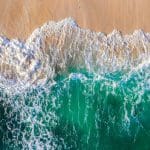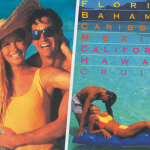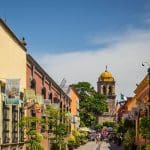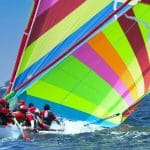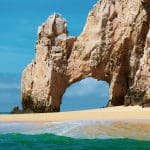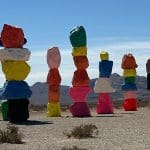Charting a different course:
How a group of eco tour operators in BC found a new mission amidst a cancelled season
Story by Ann Ruppenstein; Cover photos by Simon Ager
127 tons of marine debris removal, 42 days, nine ships, five companies, one unforgettable adventure in The Great Bear Rainforest...
With a storm rolling in calling for rough seas with strong nautical winds and up to six metre swells, eco tourism operators Kevin Smith and Russell Markel knew they were racing against time to remove the lift bags filled with tons of marine debris their crew and colleagues had collected over the last five weeks off the north coast of BC.
“There’s no way we can be there in those conditions and we were worried that the bags were going to be washed out to sea,” says Markel, the owner of Outer Shores Expeditions, one of five small ship tour operators that made up the Marine Debris Removal Initiative — a shore cleanup expedition focused on the outer coast of The Great Bear Rainforest.
As the sun set on Sept. 21, the helicopter carrying the bags of debris from the designated lift sites to a nearby tug and barge for disposal was grounded for the night due to lack of visibility. Knowing that their ships were scheduled to be at another pick-up site hours away the next morning and they couldn’t be delayed because of the impending storm, the crews sprang into action.
“They started loading these helicopter lift bags that weigh 300 kg into the bow of their Zodiacs so it was just a superhuman effort on the part of all these crews from all these companies and they just went off and got it done,” says Smith. “The mantra became leave no bag behind.”
A short while later, under the illumination of the moon, the owner of Maple Leaf Adventures could make out a small fleet of skiffs emerging from the vast darkness.
“All these little boats with these incredible mariners with their headlights and headlamps on and warn out from this incredibly long day came to us and there was this two hour period of these boats arriving,” recalls Smith, who was back on board his ship, Cascadia, ready to load the leftover bags via crane. “We got all of the bags and there was just a sense of celebration that night before all the boats had to move on and find cover before the storm hit.”
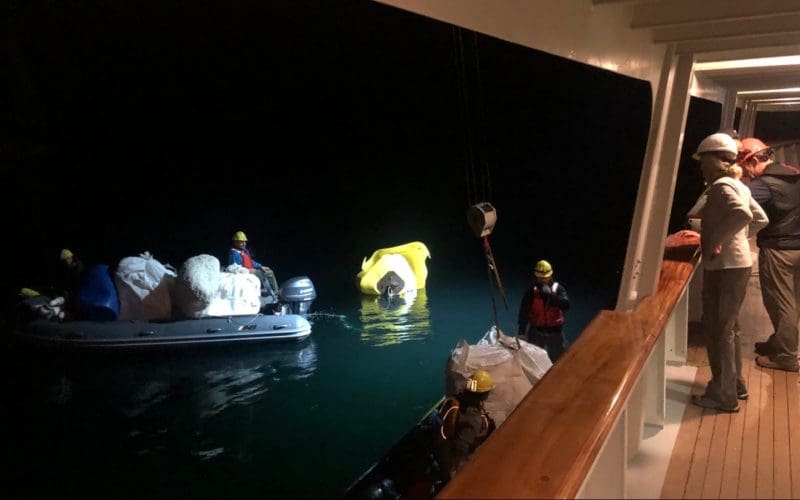
Photo: Jeff Reynolds
In the beginning
Faced with the tough reality that COVID-19 would drastically put an end to what would have been a sold out year for Maple Leaf Adventures, Smith turned his attention to finding an alternate means of staying afloat while they were unable to operate.
During a weekly Zoom meeting with members of the Small Ship Tour Operators Association of BC — a group of Canadian owned and operated, small-ship based travel companies that specialize in providing niche wilderness travel experiences in the province — he pitched the idea for a large scale cleanup project and the seeds for the Marine Debris Removal Initiative (MDRI) were planted.
“We were a support network for each other. We always showed a lot of professional courtesy around the companies, but this level of cooperation was unprecedented,” he says. “Quite frankly, it was a beautiful thing to be sharing so deeply about our concerns for our companies, and our industry, and our employees, and sharing best practices about how we’re going to get through this.”
After sussing out and developing the idea with his wife Maureen Gordon and Markel, who was also set for a sold out season from April 1 until Oct. 15 before the realities of the pandemic set in, three other companies — Ocean Adventures Charter Company, Bluewater Adventures, and Mothership Adventures — also signed up for what would turn into two back-to-back 21-day marine debris removal expeditions across nine ships.
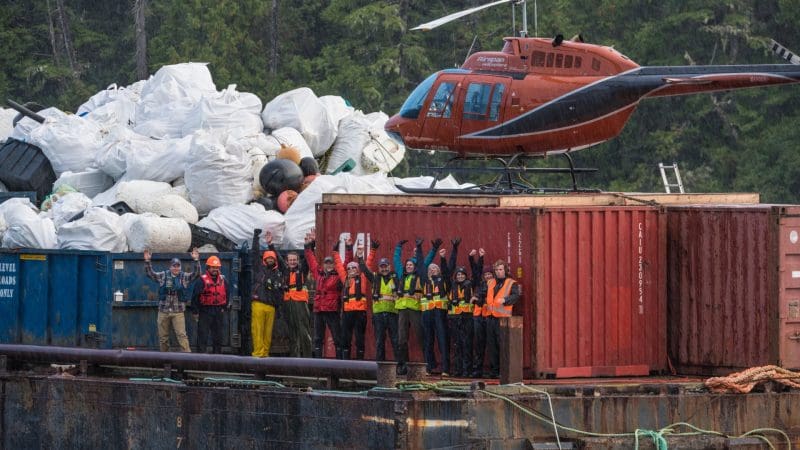
Photo: Jeff Reynolds

Photo: Jeff Reynolds
“For some of the smaller boats in the fleet, it was thought that 21 days was the maximum time that they could spend at sea with all their provisioning on board,” explains Smith. “For the first two weeks, each of the nine ships would work in the same area but each ship would be its own COVID bubble and be totally self-contained. We had the sitting ocean as our moat around our castles. Maple Leaf Adventures, we owned three of the vessels, and we didn’t even have mixing between our vessels. They were completely on their own, but we were in touch every day on marine radio and satellite phones.”
The group also got permission from Coastal First Nations, which had closed its doors to tourism as a preventive measure during the pandemic, for approval and involvement in the project.
“Even though we weren’t doing tourism, we were going to be in their territories so it was very important that we got the go-ahead and we presented our conditions and how we’d keep their communities COVID-free, such as we wouldn’t go anywhere near their communities if we needed fuel or food,” says Eric Boyum, the owner of Ocean Adventures Charter Company, noting that the ships opted instead to load up on supplies in Port Hardy at the northern tip of Vancouver Island.
During the third week of both expeditions, the group arranged a tug and barge organized from the Heiltsuk community of Bella Bella to pick up the debris collected over the previous two week period, which was destined for safe disposal at the Seven Mile Landfill on Vancouver Island.
“It was just a real bonus that we were able to contract them to help take part in this job and bring some of the money from this back into their community of Bella Bella,” adds Boyum. “Then as soon as we finished, we turned around back up for another 21-day expedition sort of mirroring the first.”

Photo: Simon Ager
Gearing up for departure
Although their initial proposal made it as far as the Prime Minister’s Office in a quest for federal funding and received positive feedback along the way, due to timing constraints — the whole project had to be completed by mid-to-late September because of weather — they then focused their efforts closer to home.
“We switched gears and started talking to the BC government and it was good timing as they were catching up on what they were doing to support businesses and the tourism industry, and it turned out that the issue of marine debris had been on the radar of the provincial government. A report had just come out in February detailing the scale of the issue and possible solutions, which included shoreline cleanups,” Markel says. “By late July we had a verbal thumbs up that this was probably going to happen, but it was kind of a harrowing moment. We’d given ourselves the drop dead date of Aug. 1 because of the weather window for doing this.”
As part of the province’s COVID-19 stimulus funding, the project wound up being supported by BC’s Ministry of Environment & Climate Change Strategy, and was the first piece of funding for the tourism industry in BC in the wake of the pandemic.
“Early on there was someone from the federal government who asked why we as tourism operators thought we were capable of pulling this off and given what we normally do in really exposed remote areas like Haida Gwaii, we were kind of shocked by that,” says Randy Burke, the owner, Bluewater Adventures. “Not all tourism is downtown city-based urban tourism. Not all boat tours are two-hour harbour tours and there’s definitely an element to rural tourism where it constantly has to deal with all sorts of challenges and it’s just part of having to operate in remote areas. What we’re talking about is a body of water that’s referred to as Hecate Strait and it has a reputation of being one of the roughest bodies of water in the world… It felt kind of good to be able to demonstrate that tourism operators are a very capable bunch.”
“Not all tourism is downtown city-based urban tourism. Not all boat tours are two-hour harbour tours and there’s definitely an element to rural tourism where it constantly has to deal with all sorts of challenges and it’s just part of having to operate in remote areas.”
Randy Burke
Photo: Simon Ager
Initially, the group expected to collect 20-30 tons of marine debris over the course of the expeditions. In the end they collected up to 10 tons a day alone during the peak period.
“A total of 127 tons of marine debris was removed and a massive volume as well because much of that was huge big chunks of styrofoam that weighed nothing,” says Smith.
High seas
Although their companies could be considered rivals, Markel says the whole initiative is a great example of what can happen when businesses view colleagues less as competitors.
“There’s so much more we can accomplish together than apart,” he states.
behind the scenes
Meet the team
Similarly, Boyum says the project created a new relationship between the business owners.
“Normally, we’re somewhat competitors — we’re friends as well, but with trade secrets and that sort of thing — but this expedition we really came together as one group with a common goal,” he says. “And the common goal was doing something really good for the environment that we love so much and also to try to put our crew members back to work.”
Reflecting on the experience from home, the camaraderie of working directly with industry colleagues also stands out as a highlight for Smith.
“I now definitely count them as close friends after we started on this in March. You may think of people in the same industry as competitors, but the support and the lifelong friendships that have been forged, I mean these are all incredible people,” he says. “It was a pivot for sure and there was a little bit of money that flowed that helped us out. Mostly it allowed us to hire our crew and to have that skill and talent remain in our industry because they had some decent employment for the summer. It was acknowledged that it was bigger than all of us and it was giving back to this coast that supports our tourism businesses. If any of us were ever asked would we give back to this coast? We’d definitely say yes, but this opportunity presented itself for us to actually walk the talk and actually help this place and to remove 127 tons of marine debris and plastic, all of which has a super negative impact for the place and the flora and fauna.”
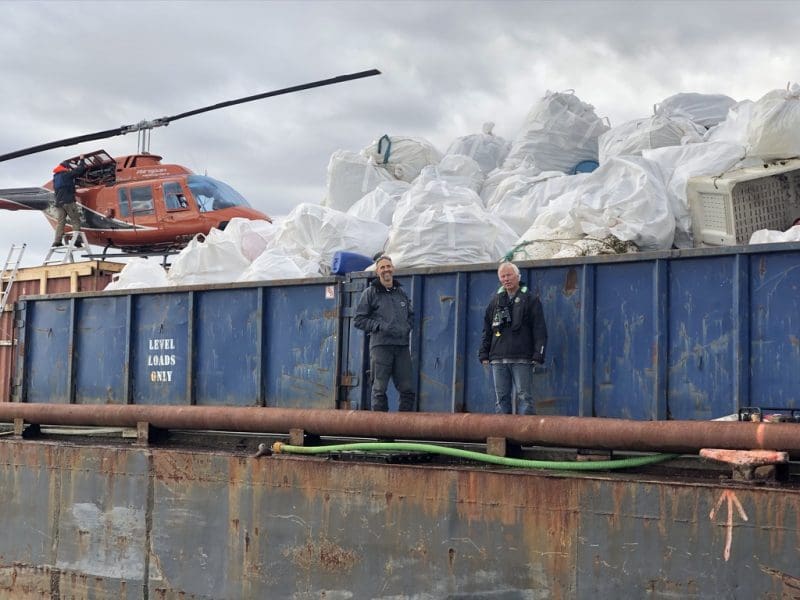
Photo: Kevin Smith
While it’s been a tough go for those in the tourism industry, Burke says this mission has given the tour operators something to feel positive about.
“It felt really good to be A) working and B) doing something positive because we’re all inundated right now by all these negative stories and it’s extremely tough times for tourism so it was for my company, for these companies, it was a good news story for us just to be able to hire back staff and get out there,” he says. “For my company alone, I hired 42 people so that’s a big thing to be able to get 42 people back to work.”
Meanwhile for Markel, he says witnessing his crew’s passion and commitment for the back-breaking hard work was amazing. Another highlight was being able to bring his partner and their four year old son along to experience the first expedition.
“What a thing for him to see and be part of. He’s still talking about it. The helicopters and the debris. And the wildlife we saw when he was on board. We bumped into mammal-eating killer whales. Breaching humpback whales. Sea otters. Pacific white-sided dolphins. Just for him to see that place, The Great Bear Rainforest, and to see our coast in that condition, it was incredibly moving,” he says. “That common sense and purpose and accomplishment that drove the whole process was pervasive throughout. We just spoke on a call with all the operators and we realized that this is something that’s a big deal. There’s a huge issue going on out there with marine debris on our coasts, and to be part of the solution is just incredibly satisfying.”
Threat to marine life and the environment
For Boyum, the whole experienced wasn’t just about how many tons of garbage was collected, but also about raising awareness about the sheer scale of the issue surrounding marine plastic and debris in the ocean.
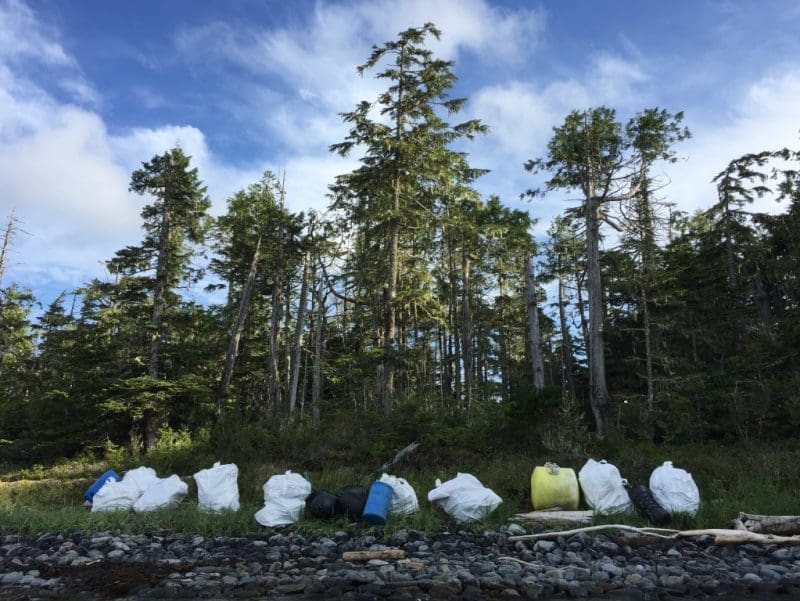
“We were able to retrieve huge pieces of old fishing nets and some of these chunks of old fishing net weighed up to a 1,000 kgs, that the next storm could easily push out to sea where they could entangle sea lions or whales,” he says. “It sort of became my small crew’s motto, we weren’t going to leave any nets behind. Nothing was too big for us to tackle and some of these nets we’d have to cut into small pieces so that we could actually fit them into a lift bag…
The scale of what we were doing with just our small hands was daunting. But the satisfaction, it was such a highlight, being able to do something that was so good for the marine environment and the animals, the fish, the birds, everything that calls it their home. We were able to give back to a coast we love so much. Our livelihoods depend on a beautiful intact coast with marine life and it just doesn’t seem right unless you are giving back to that and preserving it in whatever way you can.”
Smith says an undertaking of this size had never been done before in The Great Bear Rainforest, which is globally significant and a huge portion of what is left on the planet for coastal temperate rainforest.

Photos: Simon Ager
“Earlier this year on the BC coast there were three humpback whales that were entangled with fishing gear so that’s one of the risks whether it’s crab traps or just derelict fishing nets — whales, dolphins, otters and sea lions — it gets circled around them and they just don’t know how to get out of it. That’s one of the reasons we wanted to clean it up because of the risk to marine mammals,” explains Burke. “Secondly, all of this plastic breaks down into smaller and smaller pieces, until eventually it’s in micro plastics that the fish are eating, and honestly then when we eat the fish we’re also getting that plastic into our body.
“Third thing is, I was astounded by how much styrofoam there was. When it gets washed back into the sea, seabirds are eating it and they’re starving to death. Their stomachs are full from things they can’t digest like styrofoam and then that’s it, they starve to death so styrofoam in particular is really nasty.”
Burke says a significant amount of the debris on the coast stems from the fishing industry, such as lines, nets, buoys, floats, as well as styrofoam.
“What was also then the third ingredient was water bottles and we didn’t see this until single use water bottles came into existence 15 years ago and now it’s probably by number one of the biggest things that’s just washing up constantly on the coast,” he says.
Mission accomplished
Considering they were operating close to Fall Equinox, when the first big storm systems tend to roll in from the Pacific, for the most part it was smooth sailing during the expeditions for the MDRI crew.
“As wise mariners, we know that weather dictates our movements on the outer coast and, of course, we were on the outer coast the whole time and we were doing it late in the season, so we got very, very lucky for weather,” says Smith. “You put $15 million dollars of assets of all these ships with all these 100 crew collecting garbage and you’re taking a certain risk that you are going to be able to come back in two week’s time and pick up that garbage when the barge and helicopter arrive.”
When it was confirmed that 100% of the lift bags they’d filled with debris were removed, he put out a message over the public marine radio to the group members, “‘Alright MDRI fleet, this is Cascadia, the last bag has been lifted — it’s a wrap. We’ve achieved our goals here, well done every body.’ There was just all kinds of hooting and hollering on the radio. It was quite exciting. Best [experience] of my life.”
“It was bigger than all of us and it was giving back to this coast that supports our tourism businesses.”
Kevin Smith
Photo: Maple Leaf Adventures







